Yeovil's fire service
Yeovil's fire service
Combatting the ever-present danger
Early Yeovil comprised chiefly of wooden buildings with thatched roofs built close together and fire spreading from one burning property to its neighbours was a constant threat. In 1791 Collinson wrote of one conflagration in the town that destroyed much of the centre of the town "In the year 1449 one hundred and seventeen houses in this town were destroyed by fire, among which were fifteen houses belonging to the Chantry of the Holy Trinity, founded in the parish church here; eleven belonging to the Chantry of the Blessed Virgin Mary without the church; nineteen belonging to another Chantry of the Virgin Mary within the church and two belonging to the almshouse. Forty days of indulgence were granted to charitable contributors on this occasion." Further fires of a similar scale broke out in 1620, 1640 and again in 1643 when, yet again, many properties in the town were destroyed.
At the Quarter Sessions held at Ilchester in April 1623 it was recorded "On the humble petition of Roger Wood, John Tucker, Reyginold Woodall and Giles Mitchell of Yevel, as also on the humble request of the Portreeve, Burgesses, Ministers and other inhabitants of Yevell, that upon 23rd December last past, the houses of the said petitioners were burnt to the ground with goods to the value of 200li, whereby they are utterly undone: Ordered that the four petitioners shall have 20li from the Treasurer of the Hospitals of the western division, to be divided among them according to the discretion of the next Justices of the Peace."
For details of the Great Fire of Yeovil of 1640 and Charles I's Letters Patent - click here.
The Churchwardens' Accounts show frequent payments such as in 1715 "Pd Robert Hodges for mending two buckits .... 6d" and in 1733 "Pd Jno Coggan mending ye Church Bucketts .... 19s" (about £140 at today's value). This same year was also a payment of £3 4s (just under £500 at today's value) for a dozen new leather buckets. On 28 April 1790 a payment of one shilling was recorded "Paid a Man for collecting the Church Bucketts after Mr Garland's Fire" with the next two entries recorded payments of ten shillings and eight shillings for "Mending 4 Doz Church Bucketts" and "New Handles, Rings & Hoops to ditto". A note in the Churchwardens' Accounts for 1794 states "At Easter 1794 There was a Hundred and thirty two Buckets in good repair".
For the early part of the eighteenth century, there was no municipal fire brigade and individuals insured their property with a fire insurance company. Each insurance company generally maintained its own fire brigade, which only extinguished fires in those buildings insured by the company although sometimes, in return for a fee to be paid later, in buildings insured by other companies. Fires in properties not covered by insurance were not attended unless an insured property was in danger of catching fire as well.
Although it had not been mentioned in the Churchwarden's accounts before, on 29 April 1742 the following was written in the account book "We whose names are hereunder written being met at a Vestry held for the Town of Yeovill do impower order and direct the present Churchwardens Mr John Dier and Mr Thomas Sheane to buy (as soon as conveniently may be) one of Newsam's Engines and appropriate the same to the Use of the Town and also to repair the now Engine belonging to the said Town in such a manner as they shall think necessary and convenient."
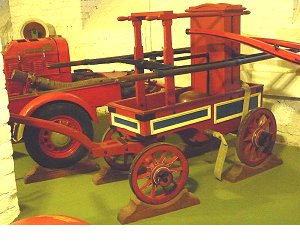 In 1725 Richard
Newsham of
London patented
"a new water
engine for
quenching and
extinguishing
fires".
Newsham's
engine, while it
probably owed
much to earlier
Dutch engines in
design, was a
great
improvement on
previous
machines. The
photograph at
left is of a
Newsham engine
in Germany. The
cistern could
hold about 140
gallons (640 litres) of water
pumping up to 85
gallons (380
litres) a
minute. Richard Newsham
died in 1743.
In 1725 Richard
Newsham of
London patented
"a new water
engine for
quenching and
extinguishing
fires".
Newsham's
engine, while it
probably owed
much to earlier
Dutch engines in
design, was a
great
improvement on
previous
machines. The
photograph at
left is of a
Newsham engine
in Germany. The
cistern could
hold about 140
gallons (640 litres) of water
pumping up to 85
gallons (380
litres) a
minute. Richard Newsham
died in 1743.
In 1742 John Coggan was again paid five shillings for "two New Bukets" and in the same year George Beard was paid fifteen shillings for repairs to the fire engine - presumably the old one. In 1745 Clement Cheesman was paid ten shillings for "Standing the Engin" and later still 2s 6d was paid "To work done about the Engin". Bucket repairs continued as an almost annual outlay as did an annual payment of ten shillings to Ann Cheesman for "Standing ye Engine" although the following year it was clarified that Widow Cheesman was paid for "standing the old engine" and not the new one. In 1751 a payment in the accounts includes a payment of 7s 6d to "Francis Butts for mending pitching 2 Dozen Church Buckets".
The accounts also make the first of several annual payments of around 1s 6d for "Oyl and Oiling the Leather pipes of Engine" as well as annual payments for "standing the engine". A later payment would be made for "Oyl and Suet to the Engin Pipes". Repairs to the engine appear to have taken place every three or four years until a note in the accounts states "At a Vestry called and legally held this 24th day of April 1753.... it is resolved at ye present Vestry that no expence for the future relating to the Fire Engines shall be brought into this Account" however the payments continued for mending buckets and standing the two fire engines from the next year!
In 1756 a new item appeared for the payment of two shillings to George King for "2 stems for ye Fire Crooks". These were long handled hooks used to pull the thatch off burning buildings in order to stop the spread of a fire.
Despite annual entries in the accounts for maintenance of the fire buckets and the engines, it is not until 1761 that a payment of 2s 6d was made for a "Contributed towards Loss by Fire" and a shilling was paid "For drawing home ye Engines at ye Fire".
The entry of 1779 in the Churchwardens' accounts is interesting because it breaks down the annual bill for the maintenance of the fire engines.
|
John
Selwood's
Bill Labour in Cleaning mending & Leathering the Little Engine Soder (solder) 3 li (pounds in weight) at 10d Leather Oil Labour in Cleaning mending and Leathering the Old Engine Leather Oil Total |
£3 10s 0d 2s 6d 8s 6d 1s 6d £1 4s 0d 8s 0d 1s 0d £5 15s 6d |
However in the same year, on 20 August 1779 the Churchwardens paid for the materials and labour to build a new, third fire engine.
|
18 Feet
Oak
Board
for the
Engine
at 5d 2 Pieces Elm Board 4 Wheels Nails 3 Days Work about the same Oil, paint, etc & Painting the Engine a Sucker Oak Nails & Work abt ye Old ditto Total |
7s 6d 9d 1s 4d 1s 0d 5s 3d 5s 0d 4s 6d £1 5s 4d |
In 1783 the Churchwardens' accounts itemised the sum of four shillings for "Cleaning the Engine after the Fire at Rev Wm Parsons's" and the same year John Williams was paid ten shillings for "Painting the Engines". On 17 April 1790 the Churchwardens paid five shillings for mending the church buckets but the following week following a fire at Mr Garland's property they had to pay a shilling ten shillings for "Mending 4 Doz Church Buckets" and eight shillings for "New Handles Rings & Hoops to Do".
In its edition of 7 January 1793, the Gloucester Journal reported "About three o'clock on Wednesday last, a fire broke out in a house in Preston, near Yeovil, Dorsetshire (sic), which for nearly three hours threatened the whole town with destruction. The wind, which was very high, blew the flames in various directions, and at the same instant five different parts of the town were on fire. By the great exertions of some Gentlemen from Yeovil, and the united endeavours of the people of the village and neighbourhood, the flames were got under; having, however, entirely consumed 14 houses and damaged a still greater number. Near 100 persons, by the melancholy accident, are, at this inclement season, destitute of homes."
In 1803 "The Town Recd of the Royal Exchange 3 Doz of Buckertts by Gift of the Sun Fire Office."
The Churchwardens' Accounts in 1807 notes "At a Vestry held and duly called this 4th of August 1807 we whose names are undersigned have ordered the Churchwardens and Overseers to produce an estimate of the expence attendant on the purchase of a new engine and the erection of a house to keep the same in. We likewise order them to enquire of the different Agents of the Fire Insurance Offices in what proportion they will severally contribute to the purchase of the said Engine, and the erection of the said house in such a spot as the Inhabitants shall deem most convenient"
In 1808 a payment of five shillings in the Churchwardens' accounts notes refers to "Keeping the Engines in House by Horse Pon ½ Year". However the next year an entry in the Accounts reads "Keeping the Engine ¼ Year in a House by the Horse Pon .... 7s 6d". After this rise, the town fire engine was kept in St John’s church, at the base of the church tower.
In 1811, following complaints that the fire engine had been damaged by the church’s bell-ringers, an appeal for subscriptions was made by local magistrates John Goodford and John Daniell to erect a new fire station. At this time there were six fire insurance companies in Yeovil although only three contributed to the appeal. Eventually nearly £120 was raised and a new fire engine house, probably little more than a large shed, was built at the junction of North Lane and Court Ash.
In 1812 by a note in the accounts "It was the wish of the above Vestry That the above named Committee should sell the larger Tub Engine, the Parish not having any occasion for it." In the same year it was decided to build an engine shed in a lean-to against the church tower, between the school (now the Chantry, but before it was moved to its present location) and the south porch. Mr William Edwards, a local blacksmith / ironmonger, was paid the following "For the Engine House in the Church Yard".
|
a large
fine
Plate
woodstock
Lock
with 2
Extra
Keys
fitted
to a large Spring Bolt a Stop Plate for ditto Door for Screws Wrate Framed Gothic Arch 18 feet Wire Lattice affixed to ditto Smiths time fixing ditto with Six Pounds of Lead a Circula Spiked Frame Bar wt 20 Pounds at 8 Smiths time fixing ditto & Head |
11s 6d 5s 0d 1s 0d 7d 9s 0d 16s 0d 6s 6d 13s 4d 3s 0d |
At a Vestry held on 20 November 1813 the following was noted "We do hereby authorise and empower the Churchwardens to pay out of the Church Rates (the expenses respecting the Fire Engines appearing to have been always paid from that Fund, and the Superintendance of the Engines having been always left to the Churchwardens) the arrears due to William Thomas for building the Engine House, amounting to £2 6s 11d; and to George Perry for Carriage Freight &c of the New Engine the sum of £6 0s 6d. We do further authorize them to get the Engine Buckets properly repaired and oiled, and to keep them and the Engines in good repair."
Further to the decision of 1812 to sell the old fire engine, it was finally sold on 8 July 1826 to Mr Etheredge for £3 11s 0d.
The Churchwardens' Accounts of 1845 show "Paid 26 Men for Attending Fire & Engines Vicarage Street - 10s 6d (4¾d each)" and 6s 0d to "Sutton & 2 man collecting & cleaning Buckets &c." Similar payments were made in February 1848 for "2 Fires in South Street".
This same year it was resolved by the Vestry "That the proposal of the Town Commissioners to take charge of the Parish Engines be accepted, and that the Churchwardens be Authorized to resign them to the Charge of the Commissioners and permit them to take their use the materials of the present Engine house." Thus the responsibility of maintaining a fire service in Yeovil passed from the Church to the Borough.
By the latter part of the nineteenth century the fire engine house had moved to a timber building on the southern corner of Vicarage Street at its junction with Silver Street. The new fire engine house was triangular in plan, shown on the 1886 Ordnance Survey and seen in the photograph below. On 31 October 1884 the Western Gazette reported "On Wednesday afternoon, the new premises erected at the corner of Vicarage Street for the accommodation of the Fire brigade were formally opened. The old engine house stood on the same site, but as increased accommodation was required, and the road at that point was too narrow for the prevailing traffic, the Town Council decided to purchase a cottage adjoining, to widen the road, to extend the length of the engine house, and to add a room over one end of it for the use of the Committee of the Brigade. The cost of these alterations amounted to about £200 (about £22,000 at today's value). The plans were drawn by Mr Vining, architect, and the work was carried out by Mr F Cox, builder."
In 1913 the fire service moved yet again, this time into the old Cheese Market building in South Street, directly opposite the Baptist church. This building remained the fire station until its demolition in May 1961 and the new fire station in Reckleford was built in 1962.
|
See also |
-
Auxiliary
/
National
Fire
Service |
map
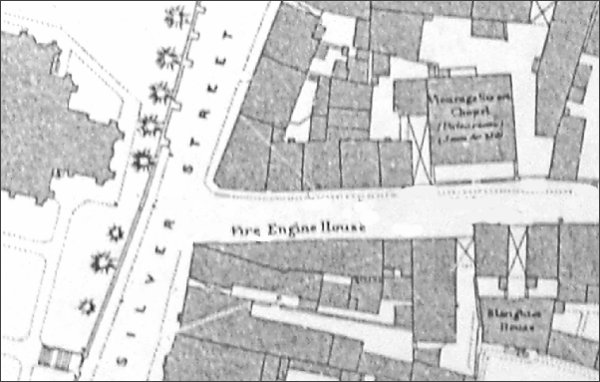
Map based on the
1886 Ordnance
Survey showing
the wedge-shaped
Fire Engine
House in
Vicarage Street
at centre.
gallery
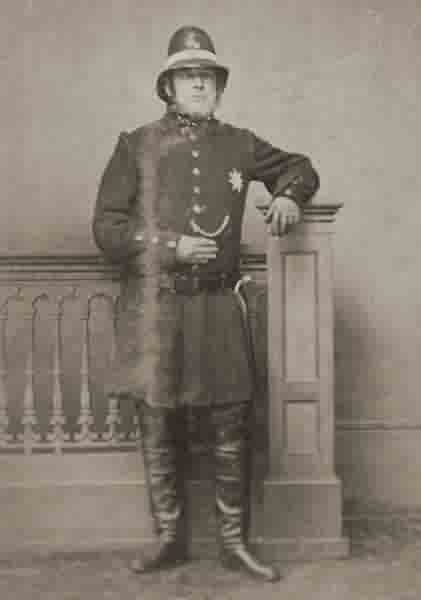
A Yeovil fireman photographed in 1864 by John Chaffin of Hendford.

Courtesy of
Colin Haine
-
This colourised photograph
features in my
book 'Yeovil
From Old
Photographs'.
Vicarage Street seen from St John's churchyard, probably during the 1950s. The triangular, single storey building at centre was for many years a fire engine house - it later became part of Denning Brothers butchers shop and provisions merchants in Silver Street. Denning's had their own slaughterhouse behind the shop.
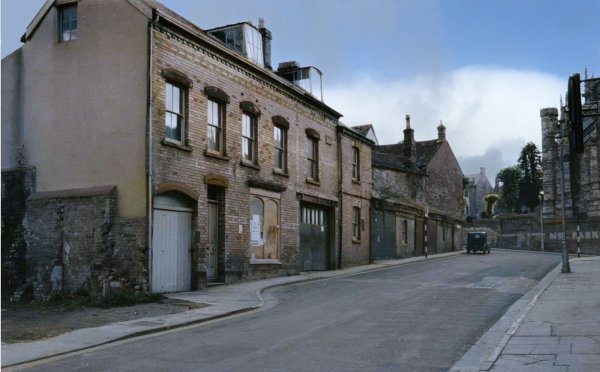
From the Cave
Collection
(colourised),
Courtesy of South Somerset Heritage Collection
This
photograph
(colourised)
features in my
book "Lost Yeovil"
Again from the mid-1960s, this photograph shows the buildings at the end of Vicarage Street. At the far end, on the corner of Silver Street, the single storey building with the car outside was for many years the fire engine house. It later became part of Denning Brothers butchers shop in Silver Street. The large two-storey building dominating this photograph was former premises of the small Engineering company Harbour & Hobbs.
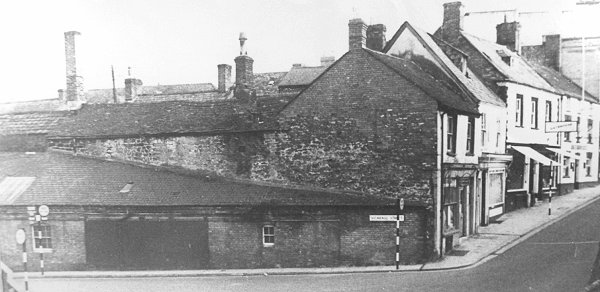
An early photograph shows the fire engine house (seen on the map above) at the junction of Silver Street and Vicarage Street as viewed from Silver Street. Silver Street continues off towards the Borough at the right of the photograph while Vicarage Street runs off to the left.
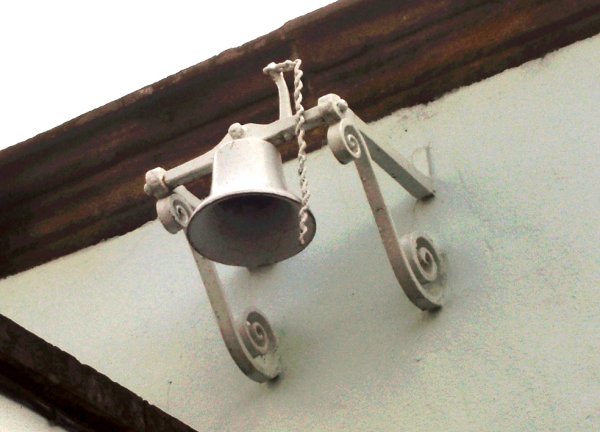
This photograph
features in my
book "A-Z
of Yeovil"
On the rear of the Town House in Union Street just below the eaves, this bell was used to summon the Fire Brigade in times of emergency from the 1840s onwards. Photographed 2013.
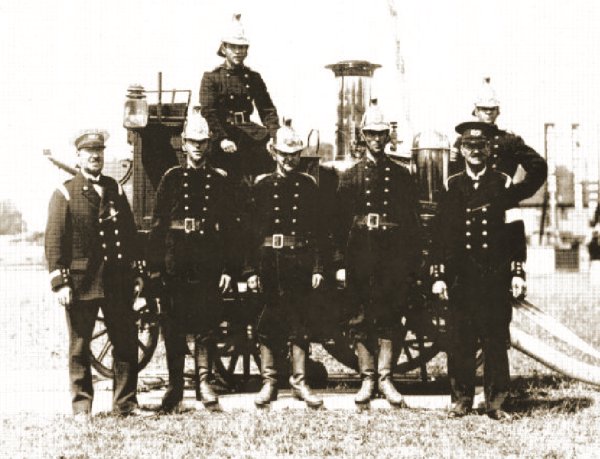
The Yeovil Fire Brigade (most likely the full complement) photographed around 1880.

From my
collection.
This
colourised photograph
features in my
book "Lost Yeovil"
Photographed by William Ross and produced as a postcard, it is dated 23 February 1906 - the date the building that had housed the King's Arms was completely destroyed by fire although it hadn't of course, been a beerhouse for several decades. The firemen in the first floor window and the crowd at ground level are facing the photographer who was standing in South Street. The man with the bowler hat is standing at the entrance to the Hall Keeper's house next to the Cheese Market. The fire, apparently, was started by an unattended candle in a rear store-room of Thomas Clement's shop in High Street, that backed on to the cottages.

From my
collection
The same image by William Ross and produced as a postcard in portrait format. The site of the burnt cottages is now the rear access yard of Argos.
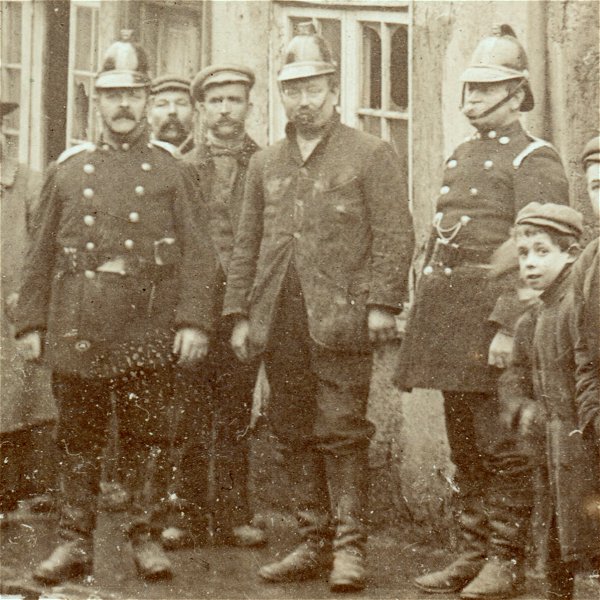
From my
collection
An enlargement of the three firemen in the previous photograph.
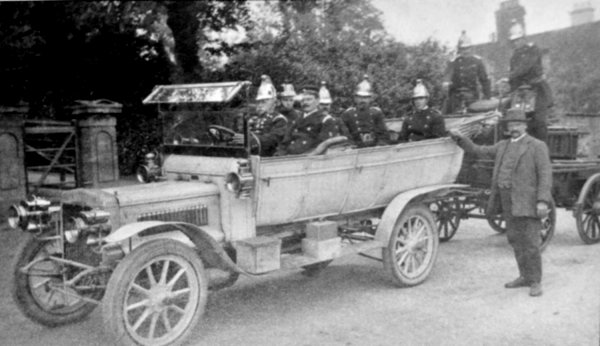
Courtesy of Rod
Dover
Probably taken around 1910, Yeovil Fire Brigade pose for a photograph at Pen House. The charabanc is towing the fire pump with ladders.

Courtesy of Rod
Dover
The Brigade pose for a group photograph outside the old Cheese Market in South Street. They took over the building in 1913 and very quickly converted it by removing the central and right arches to a single opening more suitable for the fire appliances.
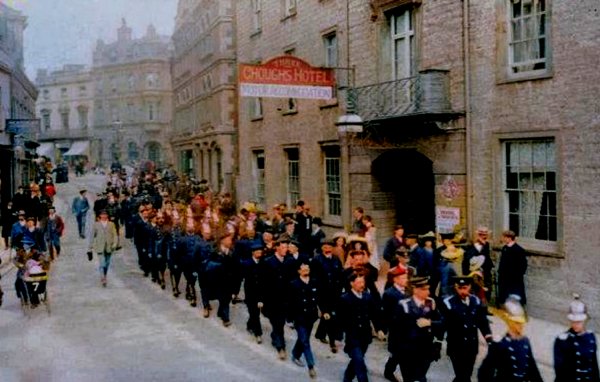
Members of Yeovil's Fire Service march down Hendford, past the Three Choughs Hotel - I'm guessing this colourised photograph was taken was during the early 1920s.
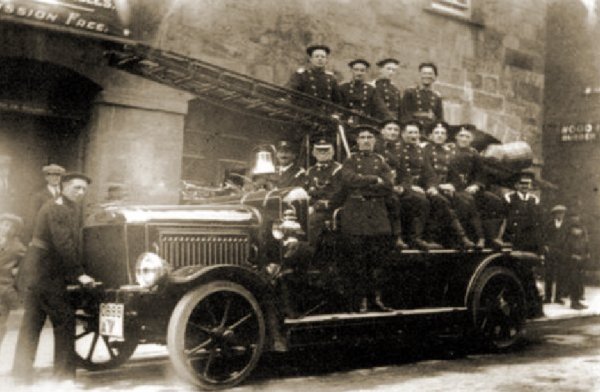
The Yeovil Fire Brigade (again, most likely the full complement) photographed during the 1920s. Many thanks to Fire Service historian Simon Rowley for the following information - "The Leyland FE in the picture was probably purchased in the early 1920s (this type was first seen about 1919) - it seems to be carrying trade-plates that would almost certainly mean that the picture was taken when the vehicle was brand new before it had its registration number issued. This is the same fire engine that the Prince of Wales is seen riding (next photo) and was probably the only motorised appliance that Yeovil had at the time."
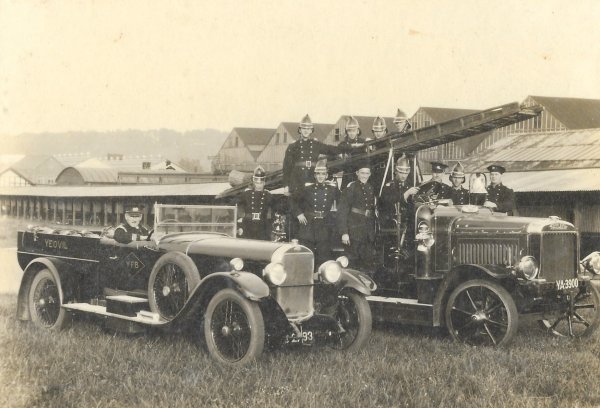
Courtesy of
Paul Pickford
Yeovil Fire Service crew photographed around 1920.
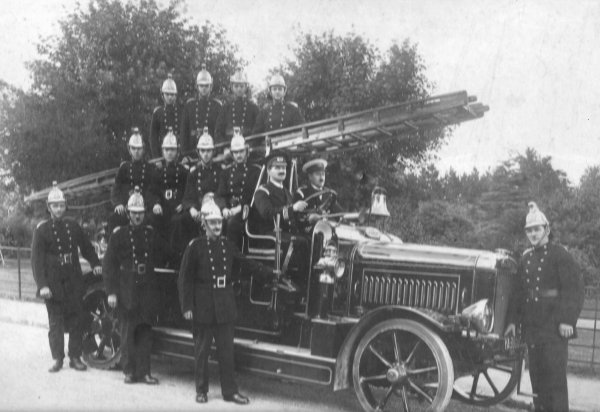
Courtesy of
Paul Pickford
The Fire
Service crew
photographed in
1924. Those
present were -
Back Row - RA
Hurley, S Peaty,
RA Robbins, A
Little
Middle Row - SH
Trask, H
Robbins, SH
Hawkins, W
Brown, Capt. DH
Hunns, Lieut. FR
Clarke
Front Row -
Engineer L
Warry, Foreman W
Andrews, Sec. VO
Dover, Driver CG
Mitchell
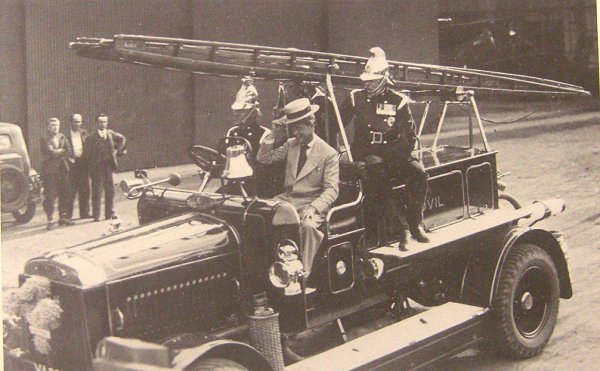
The Prince of Wales, later Edward VIII, on Yeovil's fire engine during his visit to the town in 1923.
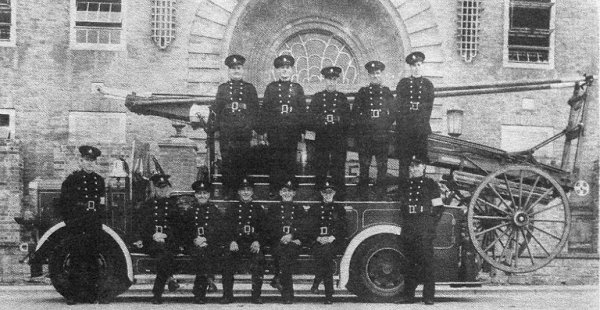
Members of the Yeovil Fire Brigade with their Leyland fire engine photographed in 1943 outside the old police station in Petters Way. Thanks again to Simon Rowley "Leyland FK6 pump escape, BYC 145, that was supplied to the brigade in May 1936. This appliance survives, fully restored, in the care of the Devon and Somerset Fire and Rescue Service."
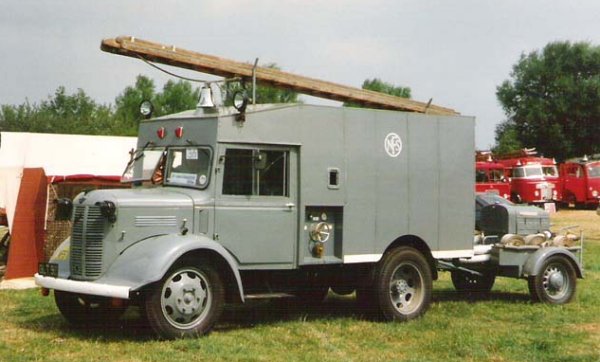
During the war the National Fire Service issued Yeovil with at least two Austin K2 auxiliary towing vehicles (ATV) coupled with trailer pumps and one of these was probably at a sub-station. This illustration is of an Austin K2 ATV in National Fire Service livery, towing a Coventry Climax FSM-Type trailer fire pump.
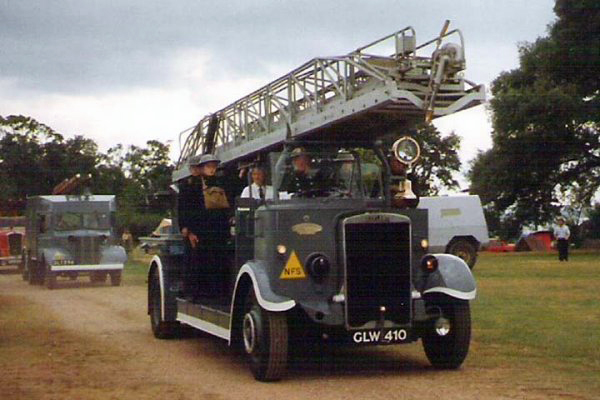
In 1943 Yeovil was issued with a Leyland Beaver with a 100ft Merryweather turntable ladder similar to this photograph. This appliance stayed at Yeovil until 1955 when it was sent to Cheltenham and Yeovil received an Austin K4 with a Merryweather 60ft turntable ladder that had initially been issued by the NFS to Barnstaple. This vehicle was preserved.

Courtesy of Paul
Pickford
Many thanks to Paul Pickford for the following description - Christmas time at the former Yeovil Fire Station in South Street. The photograph shows the 1936 Leyland Cub on the right BYC145 and earlier Leyland YA3900 on the left. This helps in dating the photo sometime between 1936 and 1938 as hostilities started in September 1939 and blackout precautions were in place.
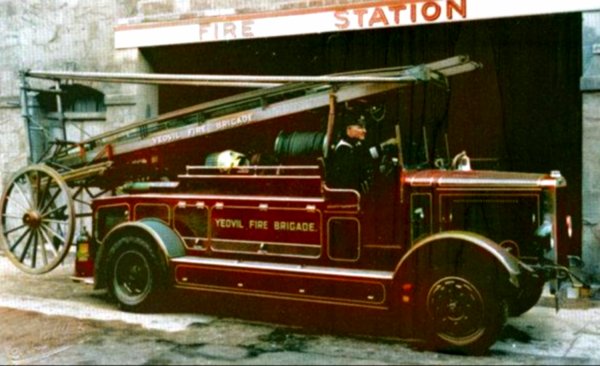
The Yeovil Fire Brigade's new engine - late 1940s? - outside the South Street Fire Station.
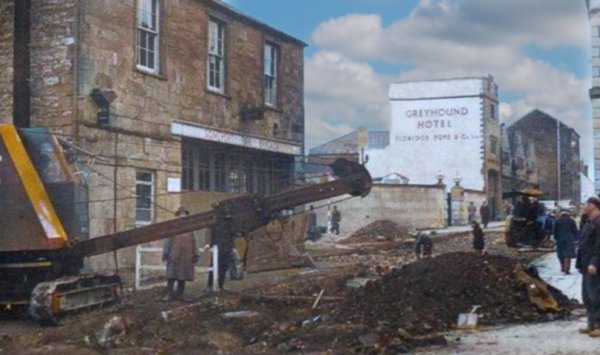
This colourised photograph, dating to about 1955, shows road works in South Street with the rebuilt Greyhound Hotel to the right, At left is the old Cheese Market building, converted in 1913 to the fire engine house.
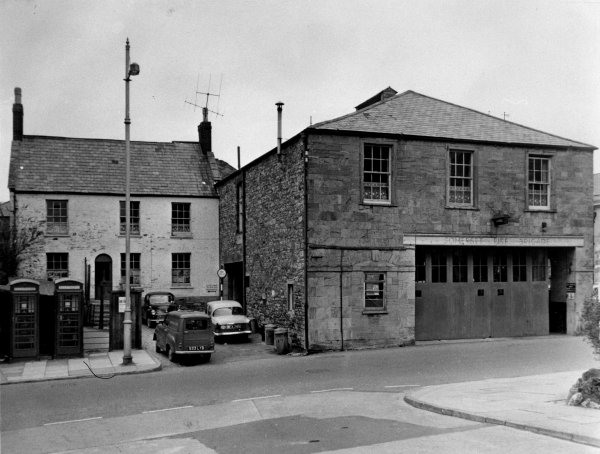
From the Cave
Collection,
Courtesy of South Somerset Heritage Collection
Seen from Petters Way, this was one of the last photographs of the old Fire Station in South Street before its demolition in May 1961.

From the Cave
Collection
(colourised),
Courtesy of South Somerset Heritage Collection
South Street Fire Station at the time of its demolition in May 1961, seen from Petters Way.

From the Cave
Collection
(colourised),
Courtesy of South Somerset Heritage Collection
This photograph, taken in May 1961, shows the Greyhound at right and the Globe and Crown at extreme left and at centre the demolition of the Fire Station, formerly the old Cheese Market in South Street.

Courtesy of
Paul Pickford
(colourised)
Paul noted "This is the additional building the Fire Brigade used near the car park in Petters Way. The building was situated at the bottom of the market site at the top of Petters Way facing out onto South Street. It was most likely constructed during the Second World War by members of the National Fire Service (NFS) to house the additional appliances that were stationed at Yeovil at the time. The appliance on the left is a Dennis F7 and was one of the first new Fire Engines delivered to the newly formed brigade. The one on the right is a wartime Austin 60Ft hand operated Turntable Ladder which remained in Service at Yeovil until 1971."
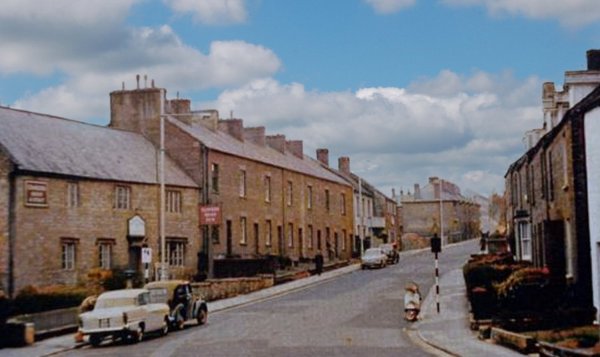
This photograph, taken in 1960, shows Reckleford Terrace (immediately right of the Glovers Arms) that was demolished for the widening of Reckleford and the construction of the ambulance and fire stations that opened in 1962. In the distance, Salisbury Terrace was demolished shortly thereafter for the Reckleford widening as were the cottages at right – built around 1850 by William Bide to house workers in his glove factory.
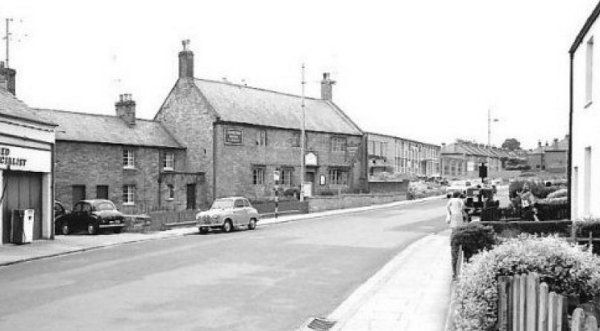
This photograph was taken in the mid 1960's. Reckleford was obviously a little wider than is apparent in the photograph above but was about to become much wider as the cottages at right in this photograph were demolished so that Reckleford could be widened even further into the dual carriageway it is today. Note too that Salisbury Terrace and the terrace next to the Glovers Arms, seen in the previous photograph, have now gone, to be replaced by the ambulance and fire stations.
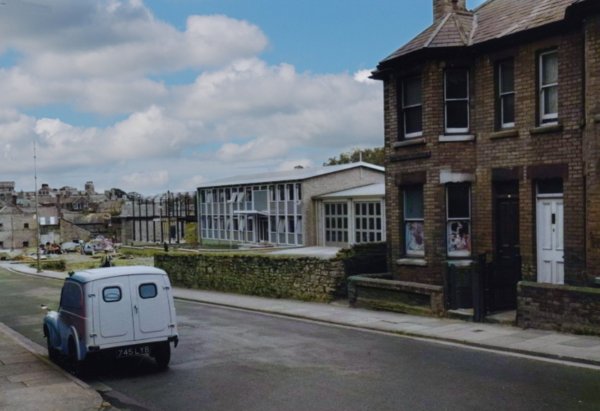
From the Cave
Collection
(colourised),
Courtesy of South Somerset Heritage Collection
Photograph of the 1960s, showing the construction of the new fire and ambulance stations on Reckleford.

From the Cave
Collection
(colourised),
Courtesy of South Somerset Heritage Collection
Again, photographed in the 1960s, the construction of the new fire and ambulance stations near completion.
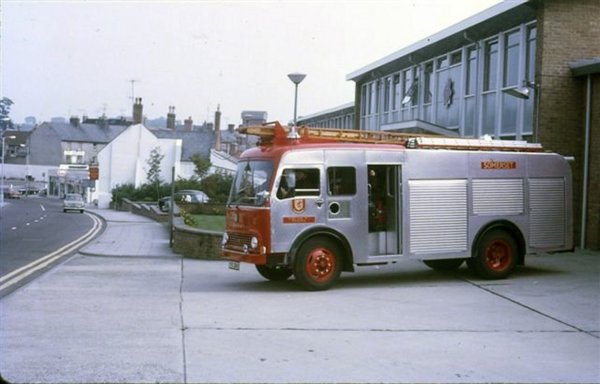
Courtesy of
Paul Pickford
A Bedford TK Fire Engine turning out on a "Shout" from Reckleford Fire Station in the early 1970's.

The Reckleford fire station in a colourised photograph of 1984.
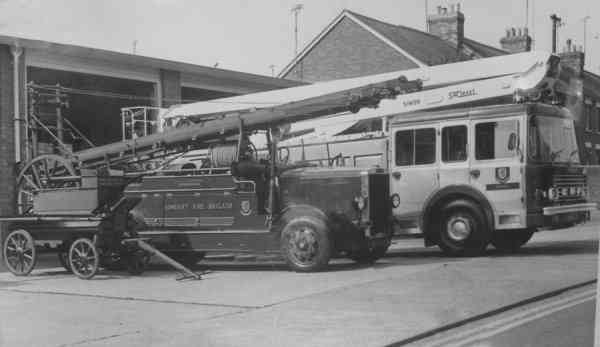
Three generations of fire appliances, photographed (probably) in the 1990s.
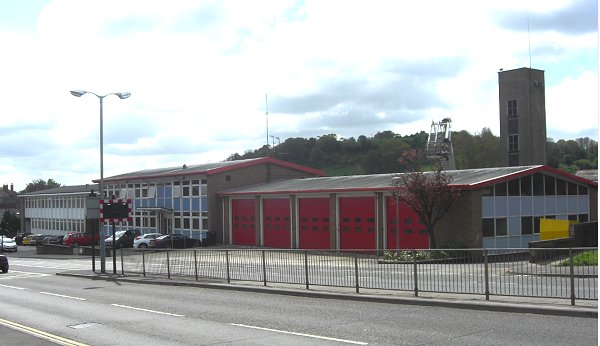
The fire station and, at far left, the ambulance station seen from across Reckleford in 2014.